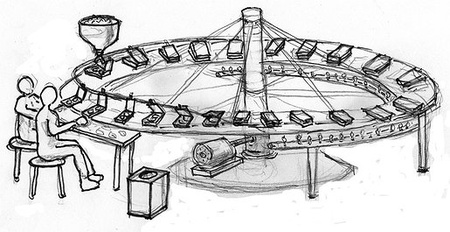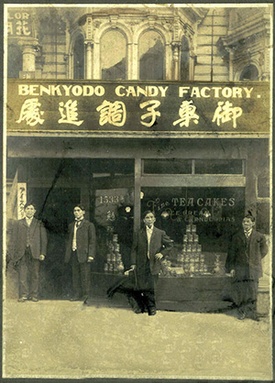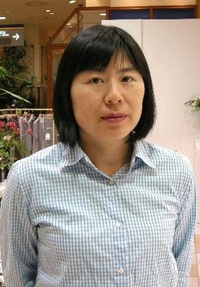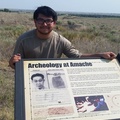Japantown Family and Personal Recollections
By now, my childhood flashback images of my grandfather’s semi-automatic sembei machine are stroboscopic visual pulsations. I drew pictures of what I saw in my mind’s eye. My Auntie Sue agreed with my memory sketches of the sembei machine and fondly recounted working alongside her father-in-law on occasion in a two-man operation sitting beside the huge carousel-like baking machine.
As a youngster, I remember being fascinated by how the machine worked. Automatically, batter would pour into the emptied griddle before it closed and continued around the curve into the baking flames. The batter would bake within the cookie mold and circle around towards the sembei workers on the other side. Approaching the workers, the griddle’s top lid peg would be lifted open by guide rails and expose the hot sweet sembei , which were then plucked out by the workers who would then place and fold the fortune slips inside.
This very same sembei machine was designed, built and operated in the first Benkyodo. I saw it operating in the second Benkyodo setup after WWII. Kiyoko Kuroda, a close childhood friend of my mother recounted seeing that sembei machine in operation and the production of fortune cookies in the basement of the original Benkyodo on Geary Street long before the outbreak of WWII.
Benkyodo continued to be the Japanese Tea Garden’s sole supplier of fortune cookies and other Japanese confectionary until the outbreak of World War II following Japan’s attack of Pearl Harbor in Honolulu, Hawaii.
World War II was the turning point for the fortune cookie becoming Chinese. Japanese businesses had to shut down because of the forced evacuation of all West Coast inhabitants of Japanese ancestry, U.S. citizen or not. Among the Japanese confectionary businesses closed were Benkyodo, Shungetsu-do, Shinanoya and Takeda in San Francisco and Fugetsudo and Umeya among others in Los Angeles. Umeya used to supply the fortune cookies to the Chinese and Japanese owned Chop Suey restaurants in Central and Southern California before the War. Of course, the Japanese owned Chop Suey restaurants were shuttered for the duration of the war, and for most, forever.
The number of Chinese restaurants increased during this time and the Chinese now had to learn how to produce their own fortune cookies. The war heightened the anti-Japanese sentiment and “patriotic” malevolence against anyone looking Japanese. In self-defense, the Chinese wore buttons proclaiming, “I’m Chinese.” The cookies at this point quietly became Chinese by default.
Micah Fitzerman-Blue, as a student at Harvard University, cited in his full-flavored 1981 essay, “The Fortune Cookie in America,”
…the expansion of the Chinese food industry during the post-WWII era is largely responsible for its (Fortune cookie) popularity…San Francisco would serve as a way station for soldiers heading overseas and a rest stop for returning soldiers, who took the time to tour around the city before heading home to the Midwest or East coast. Servicemen returned home believing that the fortune cookies were an integral part of any ‘authentic’ Chinese meal. They demanded ‘Chinese Cookies’ from their local restaurants, and orders began to trickle into California.
Although the Japanese confectioners began producing fortune cookies again after being released from the internment camps, they eventually succumbed to the now wide spread fortune cookie competition and focused on producing their other Japanese products: manju, mochi , and various rice crackers. The Umeya Rice Cake Company, founded in 1924 by the Hamano brothers, was the lone exception. They are still successfully producing fortune cookies and a variety of other Japanese snacks, which are distributed worldwide.
Japanese Tea Garden in San Francisco’s Golden Gate Park
A book published in 1979, The Japanese Tea Garden in Golden Gate Park: (1893–1942) by Tanso Ishihara and Gloria Wickham, describes,
…it was in such an ocha-ya (teahouse), in the year (1914) before the Panama-Pacific International Exposition – that the so called “Chinese fortune cookie” was served to the public for the very first time, being not an invention of any Chinese gentleman, but of Makoto Hagiwara, who neglected to patent the famous cookie he created. Sada Yamamoto (Makoto’s adopted daughter) remembers how excited the patrons of the teahouse were that morning when Makoto’s cookies first appeared alongside the blue-gray pots and cups for green tea.
Erik Hagiwara-Nagata said of what he learned from his great aunt, Haruko Hagiwara-Matsuishi and other family members,
The cookie, Tsujiura Sembei was a savory confection in Japan and it was probably sweetened to suit American tastes and it was given out, gratis, with the Green Tea, which was also introduced here in the West. The fortune cookie was made here in the Garden. It was made by hand and it had to be folded while it was still hot. The fingertips almost got burnt because it was a hot cookie. You couldn’t fold it when it was cool because the cookie would harden up. Later on, it was our baker, Benkyodo-do, they made the cookies and they brought them here.
Tomoye Takahashi, co-founder of the Takahashi Trading Corporation, remembers the fortune cookies of the early Japanese Tea Garden days. She lived next to the Golden Gate Park, where the Tea Garden is located. Her family relocated there following the 1906 earthquake. Her family and the Hagiwaras, who lived in a large house in the then larger Tea Garden, were close friends and so, the Tea Garden and Golden Gate Park was her childhood playground in the mid-1920s. When asked where she thought the fortune cookies were made, Takahashi said,
…they were made in Japantown at Benkyodo and delivered in square 5-gallon tin cans with a square tight fitting square lid for these cookies and that’s the form in which I would see them being delivered to the Tea Garden in Golden Gate Park.
I am strongly convinced that the Benkyodo sembei machine was built to meet the growing needs of the Japanese Tea Garden as stated by George Hagiwara in his 1983 letter. My Auntie Sue doesn’t recall his name, but heard that the builder was a hakujin (Caucasian). Benkyodo was contracted by Makoto Hagiwara to do so in 1918. Evidence follows that some of the sembei iron kata , used by the Tea Garden to hand make the sembei fortune cookies must have been given to Benkyodo by Makoto Hagiwara to manually make fortune cookies until the semi-automatic machine could be designed and built.
In a remote storeroom in my late mother’s home, now infrequently used by Benkyodo, I excitedly discovered about two dozen kata . My cousin, Ricky Okamura, knowing my interest in family history, let me take possession of these kata . Some had M.H. engraved on them. I believe M.H. are Makoto Hagiwara’s initials. I verified this with his great granddaughter, Tanako Hagiwara who also believes this to be true. Her family also still has some with the same initials. Some of the kata were plain and some had engravings of the words “Japan Tea” below an outline of Mount Fuji.
Yasuko Nakamachi – the Japan Connection
To me the clinching answer to the fortune cookie origin question comes by way of New York, when in the late 1980’s, Yasuko Nakamachi, was a “Big Apple” visitor from Kanagawa, Japan. She had enjoyed a delicious meal in a Chinatown restaurant, and of course following that she was served a fortune cookie - her very first! She said,
I was very impressed about how Chinese people thought of this idea of fortune in a cookie. At the time, I totally thought this was Chinese. Then, after quite some time, in about 1998, I read about Tsujiura in “Nihon no kashi,” (Japanese Sweet) article by Chihoko Kamei.
She had discovered a Japanese version of the fortune cookie she thought was strictly Chinese. Inspired, Yasuko Nakamachi did her Kanagawa University graduate thesis on the history of the tsujiura sembei , which she recognized as the antecedent of America’s fortune cookie. Today in Japan, she is considered an authority on the subject of the tsujiura sembei and its connection to the “Chinese” fortune cookie. Nakamachi has been featured in many published articles in Japan about the tsujiura sembei .
In her research, Nakamachi visited with various tsujiura confectionary shop owners throughout Japan to learn about how the tsujiura evolved in the different regions. She traveled to San Francisco where she talked with Erik Sumiharu Hagiwara-Nagata and other Japanese and Chinese Americans. Nakamachi established from Erik that the tsujiura sembei was adapted to American tastes and introduced by Hagiwara in the Japanese Tea Garden in the early 1900s. It was made sweet rather than the original savory miso flavor of the tsujiura . I can imagine that my Grandfather Okamura, a confectioner as a “retainer” to the Hagiwara Tea Garden, might have had a hand in helping to formulate the more palatable flavor for American taste.
Nakamachi traced the earliest reference to the tsujiura , in an old book, Haru no Wakakusa (Spring Grass) by Shunsui Tamenga, 1830-1844 during the Tokugawa reign. In the book the tsujiura was featured.
In her essay, “A Critical View of a Traditional Illustration,” Nakamachi reproduced a woodblock print from the National Diet Library, which was used to illustrate a story she cited from Moshiogusa Kinsei Kidan (Moshiogusa Modern Amazing Stories), from the Meiji era, 1868-1912. The story and illustration presents a character, Kinnosuke as a tsujiura shop worker using kata to bake the tsujiura sembei over a charcoal grill. The kata that were discussed in the Mock Trial and in the possession of Benkyodo and the Hagiwaras are the very same type seen used in this woodblock print.
Yasuko Nakamachi presents the fact that the tsujiura sembei has been in Japan well before the times when others claim to have come up with the fortune cookie in America. Her conclusion is that the fortune cookie in America is of Japanese origin and was introduced to America in 1914 by Makoto Hagiwara at the Japanese Tea Garden to American patrons visiting early San Francisco’s Golden Gate Park. The Japanese American version of the fortune cookie is an adaptation of the tsujiura sembei of Japan, which is documented back to 1847. The folded shape containing the message inside is the tsujiura , a Japanese invention. The primary difference is in the flavor.
Sally Osaki said that following the Historical Review Mock Trial the news media published numerous articles. Among them she cited,
U.S. Senator S.I. Hayakawa wrote a letter to the SF Examiner saying that Mrs. Osaki is on the right track, that in 1911 he visited Japan with his mother for the first time and that’s the first time he saw the senbei with the fortune inside. And he also said, yes, the Japanese have been very good about borrowing from the Chinese, but in this instance he thought, that the Chinese borrowed from the Japanese, but he said, it took a Chinese American to do that!
This all seems strong enough evidence that the fortune cookie, or at least the tsujiura , the predecessor, is of Japanese origin. I am ready and willing to proclaim that the fortune cookie as we know it today is a Japanese American adaptation of Japan’s tsujiura sembei .
Obviously, this will not change anything. The fact remains that the fortune cookie will still be served in Chinese restaurants throughout the world and because of this will continue to be assumed by most to be Chinese. So, essentially, the fame and fortune of the fortune cookie will still “belong” to the Chinese. Some still feel very strongly against this notion. Tomoye Takahashi says,
…if you ask a Caucasian, what their opinion is about the Chinese or Japanese origin, they’ll say, “So what?” - “ It isn’t important to them. Well, as a Japanese American, it’s important to me! I don’t want the fortune cookie to be mistaken for or called, Chinese cookies.
Summing it up fairly succinctly, a Chinese American in San Francisco’s Chinatown exclaimed, “The Japanese invented it, the Chinese marketed it and the Americans eat it.”
Ironically, today the Japanese Tea Garden, a San Francisco public park concession, is leased to Chinese operators! The fortune cookie that is served in the Garden’s teahouse today is produced by, you guessed it, a Chinese American, congenial Simon Chow, owner of Mee Mee Bakery in Chinatown.
In closing, I think it would be fun, almost mischievous, to organize all the Japanese restaurants throughout the world to unfailingly give out Almond Cookies to their patrons following their Japanese meals. Who knows, eventually they might become known as … “Japanese” Almond Cookies!
* * *
To see more photos about "fortune cookies," check my Nikkei Album.
Fortune Cookie Production by Benkyodo, San Francisco - 1946-1958 >>
© 2007 Gary T. Ono









